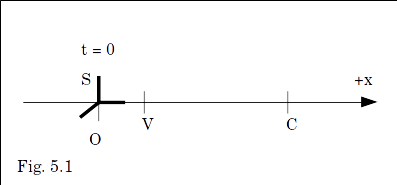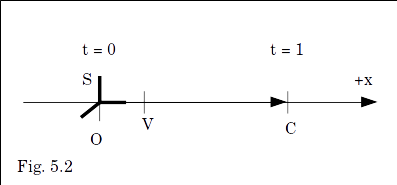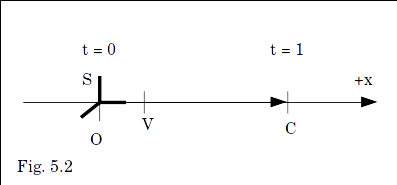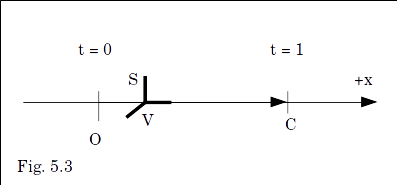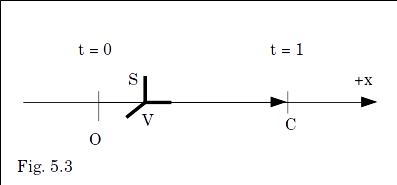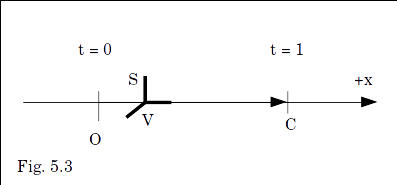

Jan Slowak
Senior Members-
Posts
79 -
Joined
-
Last visited
Content Type
Profiles
Forums
Events
Everything posted by Jan Slowak
-
You just talk and talk.
- 41 replies
-
-4
-
You just talk and talk. You dare not take hold of my concrete questions. Come with a mathematical counter-proof regarding t '= tγ (t' = t/γ). Consider the following: According to SR, LT applies to all points {(x, t), (x', t')}. SR says that t' = tγ. The verification of LT in the point of SC1: x' = 0, x = vt gives t' = t / γ. This is an clear mathematical contradiction. → LT is not self-consistent!
- 41 replies
-
-1
-
You mix my threads together. This is about time dilation. Come with a mathematical counter-proof regarding t '= tγ otherwise write no more on this thread. You or someone else. I have no desire or time to read your cheap comments.
- 41 replies
-
-3
-
You said before that you are experts and that I do not listen to what you say. I would appreciate if you speak mathematics and physics. If you want, you can disprove my claim in my second post. Refute it mathematically. Otherwise, I do not want you to reply to my posts.
-
I have written and submitted a lot of articles to physics magazines. But they are negative in the same way that you are on this forum. 2017-04-22 Einstein’s Theory of Special Relativity - a mathematical impossibility! 2017-04-16 Mathematics and Lorentz transformations 2017-04-18 The mathematics shows that the Lorentz transformations are not self-consistent 2018-11-02 Twin Paradox: ... and so they lived ... at the same age ... ever after 2018-11-03 The Lorentz transformations and mathematics/1 2018-11-10 The Lorentz transformations and mathematics/03 2018-11-14 The special theory of relativity and reality 2018-11-18 The Lorentz transformations and mathematics/02 2018-12-11 The Lorentz transformations and mathematics/04 2019-02-10 The Lorentz transformations and mathematics/05 2019-02-16 The Lorentz transformations and mathematics/06 2019-02-17 The Lorentz transformations and mathematics/07 2019-03-02 The Lorentz transformations and mathematics/08 2019-03-15 The Lorentz transformations and mathematics/09 2019-03-17 The Lorentz transformations and mathematics/10 2019-04-25 The Lorentz transformations and mathematics/11 2019-05-10 Special Relativity and Time Dilation! Their answer is the same: Thank you for your submission to … . We have assessed your manuscript and have considered its suitability for the journal very carefully. We regret to inform you that your article will not be considered for review as it does not meet our strict publication criteria. The quality and presentation of any research published in ... must be of the highest standard. Submissions should clearly demonstrate scientific rigour, extensive literature research and a careful assessment of the validity of any conclusions presented in the manuscript. Your manuscript does not meet these key publication criteria and we are unable to consider it further. We are grateful for your interest in … . Yours sincerely ...
-

Special Relativity - SR - Lorentz transformations
Jan Slowak replied to Jan Slowak's topic in Relativity
I do not want such discussions. I want to talk about the derivation of LT. Then "there" is not yet SR. If you understand what I mean. -

Special Relativity - SR - Lorentz transformations
Jan Slowak replied to Jan Slowak's topic in Relativity
I have not asked anything about quantum field theory! I wanted to discuss the derivation of LT in [7]. I have my question marks I wanted answers to. But you deviate all the time and instead of answering my questions you ask others. You dare not take a real stance! You do not run a fair scientific dialogue. Say if you want to do it! -

Special Relativity - SR - Lorentz transformations
Jan Slowak replied to Jan Slowak's topic in Relativity
Reply to anyone who mentioned QFT: Quote from Wikipedia: "In theoretical physics, quantum field theory (QFT) is a theoretical framework that combines classical field theory, special relativity, and quantum mechanics ...! You also claimed that SR is a special case of GR. Quote from: Cosmos - a short history; Stephen Hawking; swedish edition page18: "Today, the researchers describe the universe with the help of two basic sub-theories: the general theory of relativity and quantum mechanics. Unfortunately, however, we know that these two theories are incompatible - they cannot both be true ” So ... what are you talking about? You do not have to answer this because I do not give in this discussion. On this topic I wanted to talk about SR and Lorentz transformations. Only! -
[7] Modern Physics; Second edition; Randy Harris; Chapter 2; Special Relativity; 2008 In the derivation of LT in [7], three special cases are used to determine the constants A, B, C, D. The result of this derivation gives the following: B = −Av, C = −Av/c2, D = A, A = γ. If you replace these values in LEx': x' = Ax + Bt LEt': t' = Cx +Dt you get LTx': x' = (x – vt)γ LTt': t' = (t – vx/c2)γ It is these two equations that are LT. But during the derivation, the combination LEt', SC1 is not used. Therefore, we make a verification of a solution (as one should always do). We calculate LTt' in SC1: LTt': t' = (t – vx/c2)γ SC1: x' = 0, x = vt → t' = (t-v(vt)/c2)γ → t' = t(1-v2/c2)γ → t'= t/γ My comment: In the derivation of LT in [7] is used LEx ', LEt', SC1, SC2, SC3 and as a result you get time dilation t' = tγ. But the verification of the derivation, LTt' with SC1 gives us t'= t/γ. This shows that the derivation of LT in [7] is not self-consistent! This is one of the reasons I said that SR is nonsense. I regret that everyone is upset by my conclusion but I have a lot more aspects of SR that I have analyzed in detail and everyone shows the same thing.
- 41 replies
-
-4
-

Special Relativity - SR - Lorentz transformations
Jan Slowak replied to Jan Slowak's topic in Relativity
I would like to ask everyone to look again at the pictures Fig. 5.1, 5.2, 5.3. For the most part, I talk about the distances on the x-axis and their length. I'm not going to complicate the pictures with units of measure. Can you then confirm or reject (you can say yes or no if you want) if the following applies in all three pictures: length (OV) = v, length (OC) = c, length (VC) = c - v. Thank you, I stop for the day. Will continue tomorrow. -

Special Relativity - SR - Lorentz transformations
Jan Slowak replied to Jan Slowak's topic in Relativity
If you do not understand what I mean in the pictures Fig. 5.1, 5.2 and 5.3 and if you have problems interpreting when using speed and when using distance then I wonder if you understand what the following equation is about: E=mc² For the most part, they do not stand which units of measurement you use! -

Special Relativity - SR - Lorentz transformations
Jan Slowak replied to Jan Slowak's topic in Relativity
If you do not understand what I want to say in the pictures Fig. 5.1, 5.2 and 5.3 then I can not help you.- 65 replies
-
-1
-

Special Relativity - SR - Lorentz transformations
Jan Slowak replied to Jan Slowak's topic in Relativity
Please read carefully what I wrote! -

Special Relativity - SR - Lorentz transformations
Jan Slowak replied to Jan Slowak's topic in Relativity
If we talk about speeds then c and v have the unit of measure km/s. If we talk about distance then c and v have the unit of measure km. distance = speed * time → c km/s * 1 s = c km v km/s * 1 s = v km It should be as simple as possible. Things that are implied need not be drawn or written. -

Special Relativity - SR - Lorentz transformations
Jan Slowak replied to Jan Slowak's topic in Relativity
Thank you! -

Special Relativity - SR - Lorentz transformations
Jan Slowak replied to Jan Slowak's topic in Relativity
Can you refer to the bibliography where I can read about how SR is used in GPS? -

The Special Theory of Relativity - Special Relativity - SR
Jan Slowak replied to Jan Slowak's topic in Speculations
I know, I have no rights, you have all of them! -

Special Relativity - SR - Lorentz transformations
Jan Slowak replied to Jan Slowak's topic in Relativity
When you say "your ignorance in this area" then you have judged me in advance and you hurt me as others have done before. I do not understand this. Here I acknowledge that I do not understand: what are you for people who use such methods on an open site. You cannot approve another opinion, not even discuss. Why? The fact that I have begun to ask clear questions about small things is because you deviate all the time from the main problem. I want to pursue my reasoning. I don't want to hear other things. But it is enough to say: You are wrong! But then you have to justify! You talk about computers and GPS. What does SR have to do with computers? I've never heard that! Can you refer to the bibliography where I can read about how SR is used in GPS. Thanks! -

The Special Theory of Relativity - Special Relativity - SR
Jan Slowak replied to Jan Slowak's topic in Speculations
I have started this thread to discuss my ideas, my pictures. Why do you ask for v' ? Start your own thread!- 66 replies
-
-1
-

Special Relativity - SR - Lorentz transformations
Jan Slowak replied to Jan Slowak's topic in Relativity
An object (inertial reference system, IRS) moves on the x-axis to the right, toward +x. The IRS moves at a constant speed v m/s. At time t = 0, the IRS passes the point O on the x-axis. We measured the time in seconds. When the clock shows t = 1, the IRS passes the point V on the x-axis. Then the length of OV = v meters. It is quite obvious. We do not need to constantly use unit of measurement. We do it for the sake of simplicity! We say that the light moves at speed c but we know that c = 300,000 km/s. Your question is unfounded, such things should be obvious! But you can answer the question of whether the length of the distance OV in this example is v? Yes or No.- 65 replies
-
-1
-
One of the results of SR is time dilation, TD. Check for example https://en.wikipedia.org/wiki/Time_dilation There and in all other books I read about SR there is a relationship between the time t' from S' and t from S. S and S' are two inertial reference systems that move relative to each other at constant speed v. Here I indicate this relationship: t' = tγ where γ = 1/(1-v2/c2)1/2 is called the Lorentz factor, LF. My question to you: Is it true that the concept of time dilation is depicted with this formula? Yes or No.
-

Special Relativity - SR - Lorentz transformations
Jan Slowak replied to Jan Slowak's topic in Relativity
Answer to Strange, swansont, Ghideon Title to this thread is called: Special Relativity - SR - Lorentz transformations. I'm talking about the derivation of LT. In this phase of the review of SR we cannot talk about RS principles, time dilation and the like. It can happen later. I was looking to get a correct picture for SC3 in [7]. But you are not pedagogical in your progress! What I have described in Fig. 5.1, 5.2, 5.3 is so clear and simple that a student in the first year of high school would answer the question directly: Yes. If you all answer No, I will end this thread.- 65 replies
-
-2
-

The Special Theory of Relativity - Special Relativity - SR
Jan Slowak replied to Jan Slowak's topic in Speculations
?! -

Special Relativity - SR - Lorentz transformations
Jan Slowak replied to Jan Slowak's topic in Relativity
Answer to Strange, swansont, Ghideon: I asked you to confirm that in Fig 5.1, 5.2 and 5.3 the lengths of the three distances are as follows: length (OV) = v, length (OC) = c, length (VC) = c - v Nothing else! You should not draw any other pictures. We talk about pictures I have drawn. You should not deviate from the subject. You should not ask any further questions. If you are a physicist or mathematician with college education then you just need to answer my question. The answer should be Yes or No. If you answer No, you can argue briefly. Thanks!- 65 replies
-
-4
-

Special Relativity - SR - Lorentz transformations
Jan Slowak replied to Jan Slowak's topic in Relativity
We start almost from the beginning. Fig 5.1: A reference system S is on the x-axis in the point O. Clock shows t = 0. The reference system S is at rest against the point O. We mark two points on the x-axis. Points V at distance v from O. Point C at distance c from O. Three distances are formed. OV, OC and VC. length (OV) = v, length (OC) = c, length (VC) = c - v. Fig 5.2: The reference system S is at rest against the point O. A light signal occurs at point O. This signal moves at the speed of light c. We only consider the light beam coinciding with the x-axis. When clock shows t = 1, wave-front reaches point C. The following still applies: length (OV) = v, length (OC) = c, length (VC) = c – v. Fig 5.3: The reference system S moves from left to right with speed v < c. At the moment when S is in O a light signal occurs in O. We only consider the light beam coinciding with the x-axis. When clock shows t = 1, reference system S reaches point V and wave-front reaches point C. The following still applies: length (OV) = v, length (OC) = c, length (VC) = c - v. These three pictures show what happens in reality. They also show that the wave front movement is independent of any reference systems that would happen to be there or elsewhere. Then I ask the question to all of you: Is it true that the lengths of the three distances in Fig. 5.3 are the following: length (OV) = v, length (OC) = c, length (VC) = c - v?

